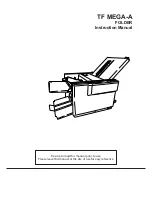
10
Operating Procedure Formech FM660
Turn the isolator switch situated on the electrical box on the rear of the mach
ine to the ‘ON’
position.
Using the heater controls, turn the zones on to provide power to the heaters. It usually takes
between 15 and 20 minutes before the heaters have reached their operating temperature.
Place your mould onto the drape table. See the section dealing with mould design to ensure
that your mould is suitable. Place the table into the lower position by pushing the table lever
(6)
away from you.
Open the material clamps
(1)
and raise the clamp frame. Position a sheet of plastic over the
aperture. See the section dealing with plastics to ensure that your material is suitable.
Pull the clamp frame down and close the material clamps. The plastic should completely cover
the white seals around the aperture. Use the adjusting screws at the front of the material
clamps to properly grip the plastic. The rear of the clamp is spring loaded. The pre-load spring
tension can be adjusted by moving the position of the two lock nuts.
After the heater has reached operating temperature, pull it forward over the plastic using the
handle at the front of the heater unit.
Activate the auto-level by touching the blue button. This enables the auto-level feature. If the
plastic is sagging and not being heated evenly then the auto-level feature may be used to keep
the plastic level while the heater is forward and until ready to form a mould.
As the plastic heats up it may begin to rise slightly. It will then soften and begin to drop back.
If the heating cycle time is known then the timer can be set prior to bringing the heater forward.
If not using the timer push the heater back slightly to test the softness of the plastic manually or
to observe its state. Continue heating until it is soft enough to form. At this point, push back the
heater all the way.
Touch the white pre-stretch button to inflate the plastic before moulding if required. This feature
is particularly useful if the mould is high because it keeps the plastic at a more even thickness
throughout the moulding. Pre-stretch may also be used as the table is rising to keep the bubble
inflated. If the moulding is quite high it may be necessary to pre-stretch the plastic before
moulding takes place.
Press the green ‘Mould’ button
and lift the mould table by pulling back the drape table lever until
the crank locks in place and the drape table is fully raised.
The green mould button is used to apply vacuum to the table. The moulding will form around
the tooling.
For the powered table option the table is raised by touching both the two red ‘Table Up’ buttons
simultaneously (this must be performed with both hands and held until the table is fully up).
At the appropriate time the fans may be turned on to start the plastic cooling process
– touch
the white ‘ON’ button. When the moulding is cooled, touch the white ‘OFF’ button.
Once the plastic has cooled sufficiently the yellow release button may be pressed to blow the
moulding off of the mould. Too long or too soon a release may distort the moulding.
Once released the moulding is now complete and the table may be lowered using the drape
table lever and the clamp frame unclamped. To lower the powered table
touch the ‘Table Down’
button, holding this until the table has reached its lower position.






































